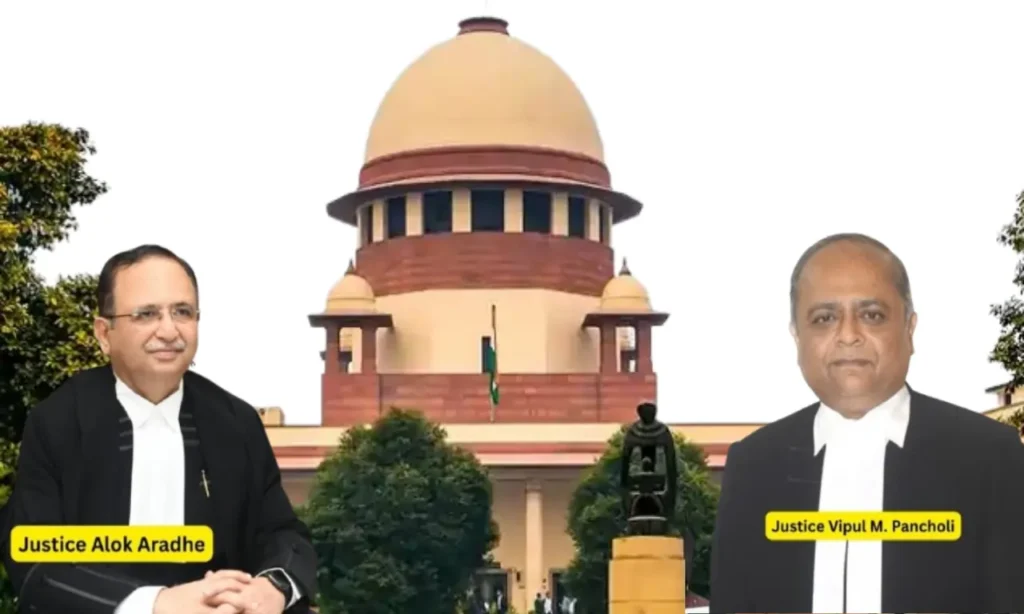New Delhi : In a significant development for India’s judiciary, two new judges were appointed to the Supreme Court on August 29, 2025, restoring the apex court to its full sanctioned bench strength of 34 judges. Justices Alok Aradhe and Vipul M. Pancholi were sworn in by Chief Justice of India B.R. Gavai, marking a return to complete judicial capacity that had been pending for some time. This move comes under the Collegium system, a cornerstone of judicial appointments in India, governed by Articles 124 and 217 of the Constitution for the Supreme Court and High Courts respectively.
The Collegium system, established through landmark Supreme Court judgments, involves recommendations for judge appointments made by a panel of senior judges. For Supreme Court appointments, the Collegium comprises the Chief Justice of India (CJI) and four other senior-most judges. For High Court appointments, it includes the CJI and two senior-most Supreme Court judges. This process ensures judicial independence, with the President formally appointing the judges based on these recommendations.

Evolution of the Collegium System: From Executive Dominance to Judicial Primacy
The Collegium system’s roots trace back to pre-1980s practices when judicial appointments were largely controlled by the executive branch. The President appointed judges in consultation with the CJI, but this consultation did not imply mandatory agreement.
A pivotal shift occurred with the First Judges Case in 1981, where the Supreme Court ruled that ‘consultation’ with the CJI did not equate to ‘concurrence,’ thereby granting primacy to the executive in appointments.
This changed dramatically in the Second Judges Case of 1993, when the court interpreted ‘consultation’ as ‘concurrence,’ birthing the Collegium system. Initially, it consisted of the CJI and two senior-most judges.
The Third Judges Case in 1998 expanded this to include the CJI and four senior-most judges, solidifying the framework.
In 2015, the Fourth Judges Case struck down the National Judicial Appointments Commission (NJAC) and the 99th Constitutional Amendment Act as unconstitutional, restoring the Collegium system amid debates over transparency and executive involvement.
These historical milestones set the stage for the recent appointments, emphasizing the system’s role in maintaining judicial autonomy.
Swearing-In Ceremony: Justices Aradhe and Pancholi Join the Bench
On August 29, 2025, Chief Justice of India B.R. Gavai administered the oath to Justices Alok Aradhe and Vipul M. Pancholi in New Delhi. Photos from sources like solapur.dcourts.gov.in and patnahighcourt.gov.in captured the moment, with Justice Aradhe on the left and Justice Pancholi on the right.
With these elevations, the Supreme Court achieved its full strength of 34 judges, a status expected to hold until CJI Gavai’s retirement on November 23, 2025.
Justice Pancholi, notably, is positioned to become the next CJI under the seniority norm, serving from October 3, 2031, until his retirement on May 27, 2033.
The appointments were notified on August 27, 2025, just 48 hours after the Collegium’s recommendation on August 25, reflecting swift governmental action.
Controversy Surrounds Justice Pancholi’s Appointment: Dissent from Justice B.V. Nagarathna
The elevation of Justice Pancholi sparked controversy due to a rare dissent from Collegium member Justice B.V. Nagarathna. In her note, she warned that appointing Justice Pancholi, ranked 57th in the all-India High Court judges’ seniority list, could be “counter-productive” to the administration of justice and stake the credibility of the Collegium.
Justice Nagarathna highlighted that several meritorious judges senior to him were overlooked. Despite her objections, the Collegium approved the recommendations by a 4:1 majority.
Central to her dissent was Justice Pancholi’s transfer from the Gujarat High Court to the Patna High Court in July 2023, described as a product of deliberate consultations rather than routine. She referenced inputs from judges like retired Justice M.R. Shah, Justice Vikram Nath, Justice J.B. Pardiwala, and then Gujarat CJ Aravind Kumar.
Additional concerns included seniority issues and representation balance, noting that with Justices Pardiwala and N.V. Anjaria already from Gujarat on the Supreme Court, adding a third could skew geographic equity, leaving other High Courts under-represented.
Justice Nagarathna urged reviewing confidential materials related to the transfer and sought her dissent’s publication for transparency, though the official resolution did not include it initially.
This dissent echoes broader criticisms, including from NGO Campaign for Judicial Accountability and Reforms (CJAR), which questioned the 4-1 split, lack of transparency, and Pancholi’s low seniority. CJAR noted he would be the third from Gujarat, superseding three senior women judges and 21 chief justices.
Professional Background of Justice Vipul M. Pancholi
Born on May 28, 1968, in Ahmedabad, Justice Pancholi enrolled as an advocate in September 1991, practicing at the Gujarat High Court. He served as assistant government pleader and additional public prosecutor for seven years until March 2006.
Elevated as an Additional Judge of the Gujarat High Court in October 2014, he was confirmed permanent in June 2016. Transferred to Patna High Court in July 2023, he took oath on July 24, 2023, and became its Chief Justice on July 21, 2025.
Ranked 19th among High Court Chief Justices, his parent High Court is Gujarat. His elevation supersedes many seniors, positioning him for CJI in 2031 for nearly 18 months.
Justice Nagarathna’s objections trace back to May 2025, when his name was considered but not cleared, with Justice N.V. Anjaria elevated instead. It resurfaced three months later, leading to her renewed dissent.
Career Trajectory of Justice Alok Aradhe
Justice Alok Aradhe, born in April 1964 (specifically April 13, 1964), has a distinguished career across multiple High Courts. Enrolled as an advocate on July 12, 1988, he specialized in civil, constitutional, arbitration, and company matters at the Madhya Pradesh High Court in Jabalpur, earning senior advocate designation in April 2007.
Appointed Additional Judge of Madhya Pradesh High Court in December 2009 (December 29, 2009), he became permanent in February 2011 (February 15, 2011). Transferred to Jammu and Kashmir High Court in September 2016 (September 20, 2016), he served as Acting Chief Justice from May 11, 2018, to August 2018.
Later transferred to Karnataka High Court in November 2018 (November 17, 2018), he was Acting Chief Justice from July 3, 2022, to October 14, 2022 (July to October 2022).
Appointed Chief Justice of Telangana High Court in July 2023 (July 19, 2023; oath July 23, 2023), he was transferred to Bombay High Court as Chief Justice on January 21, 2025.
Ranked third among High Court Chief Justices, his parent High Court is Madhya Pradesh.
Broader Implications for Judicial Diversity and Representation
These appointments highlight ongoing issues in judicial diversity. Justice Nagarathna remains the lone woman judge on the bench post these elevations. The last recommendations for women judges were in 2021, with no further since.
Justice Pancholi’s rise, despite being 57th in seniority, has superseded three senior women judges and many chief justices, raising questions about gender and regional balance.
The Supreme Court now operates at full strength, but the dissent underscores tensions in the Collegium system, with calls for greater transparency.
Conclusion: A Milestone Amid Debates on Judicial Reforms
The appointments of Justices Aradhe and Pancholi on August 29, 2025, mark a milestone for the Supreme Court, achieving full bench strength amid evolving discussions on the Collegium system’s efficacy. While celebrating judicial reinforcement, the dissent and criticisms highlight needs for enhanced transparency, diversity, and balanced representation. As India looks ahead, with Justice Pancholi potentially leading as CJI in 2031, these events could influence future reforms in judicial appointments.
Frequently Asked Questions
1. Who are the newly appointed Supreme Court judges in August 2025?
Justices Alok Aradhe and Vipul M. Pancholi were sworn in as Supreme Court judges on August 29, 2025, by Chief Justice of India B.R. Gavai, bringing the court to its full sanctioned strength of 34 judges.
2. What is the Collegium system in India?
The Collegium system is a mechanism for recommending judges for appointment to the Supreme Court and High Courts. It consists of the Chief Justice of India and four senior-most Supreme Court judges for Supreme Court appointments, and the CJI with two senior-most judges for High Court appointments. The President formally appoints judges under Articles 124 and 217 of the Constitution.
3. Why was Justice Vipul M. Pancholi’s appointment controversial?
Justice Pancholi’s elevation sparked controversy due to a dissent from Collegium member Justice B.V. Nagarathna, who cited his 57th rank in the all-India High Court judges’ seniority list, his 2023 transfer from Gujarat to Patna High Court, and concerns over regional imbalance, as Gujarat already has two Supreme Court judges.
4. What is the significance of the Supreme Court reaching its full strength?
With the appointments of Justices Aradhe and Pancholi, the Supreme Court achieved its sanctioned strength of 34 judges on August 29, 2025, ensuring optimal judicial capacity until CJI B.R. Gavai’s retirement on November 23, 2025.
5. When will Justice Vipul M. Pancholi become Chief Justice of India?
Justice Pancholi is in line to become Chief Justice of India from October 3, 2031, following Justice Joymalya Bagchi’s retirement, and will serve until his retirement on May 27, 2033, for nearly 18 months.

